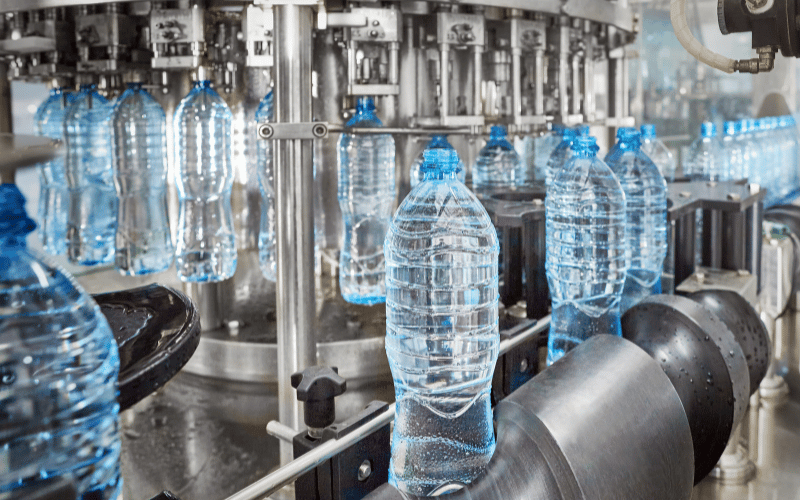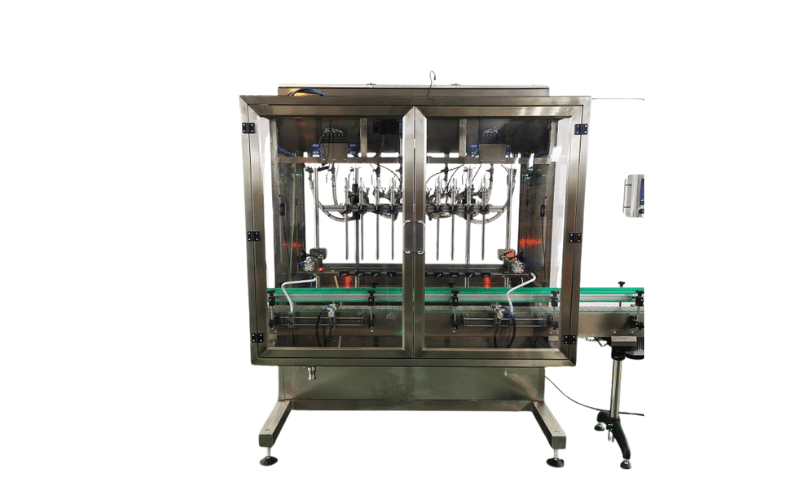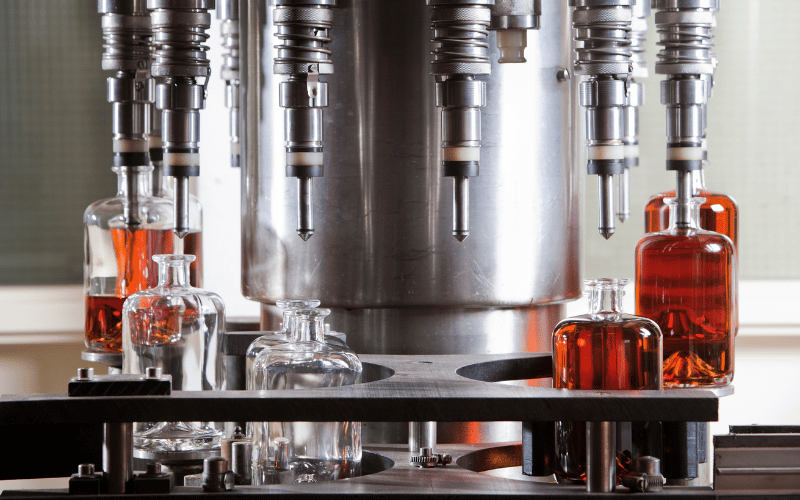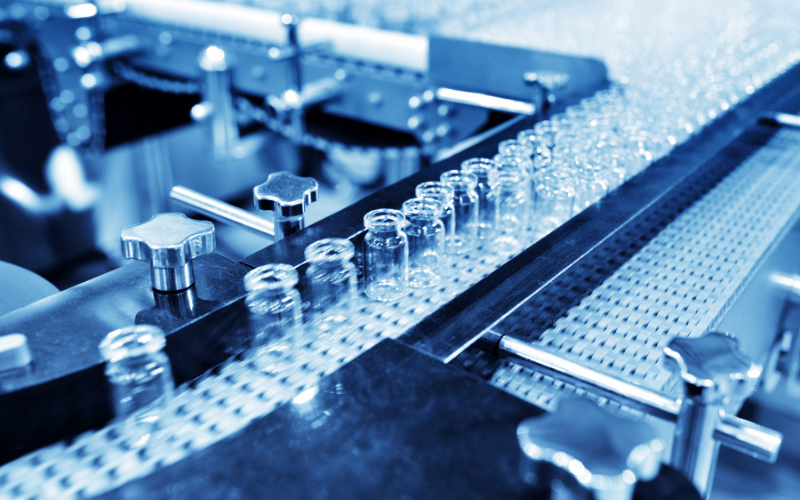جدول المحتويات
تبديلمقدمة
تلعب خطوط التعبئة دورًا محوريًا في التصنيع، إذ تُبسّط عملية التعبئة والتغليف وتضمن تجهيز المنتجات بكفاءة للتوزيع. تُحسّن هذه الأنظمة الإنتاجية، وتحافظ على الاتساق، وتلبي الطلب الكبير في مختلف القطاعات. تعتمد قطاعات مثل المشروبات والمياه المعبأة والنبيذ ومنتجات العناية الشخصية اعتمادًا كبيرًا على خطوط التعبئة لتوفير الجودة والراحة للمستهلكين.
ما هو خط التعبئة؟
خط التعبئة هو نظام متكامل مصمم لأتمتة عملية التعبئة، والختم، ووضع العلامات، وتغليف المنتجات في زجاجات للتوزيع والبيع. تلعب هذه الأنظمة دورًا حيويًا في الإنتاج من خلال ضمان الكفاءة والاتساق وقابلية التوسع، لا سيما في قطاعات مثل المشروبات والأدوية والعناية الشخصية. تُبسط خطوط التعبئة العمليات، وتُقلل من العمل اليدوي، وتُحافظ على معايير الجودة العالية، مما يجعلها ضرورية للشركات التي تحتاج إلى تلبية متطلبات الإنتاج واسعة النطاق.
العمليات الرئيسية في خط التعبئة
تتألف خطوط التعبئة من عدة عمليات مترابطة تُسهم مجتمعةً في تغليف المنتجات بسلاسة. فيما يلي شرح مُفصّل للمراحل الرئيسية:
حشوة
عملية التعبئة هي جوهر أي خط تعبئة. تتضمن نقل المنتج - سواءً كان سائلاً أو جلاً أو مسحوقاً - إلى زجاجات بدقة وسرعة. تضمن آلات التعبئة المتطورة قياسات دقيقة لتقليل الهدر والحفاظ على اتساق المنتج. يستخدم المصنعون، حسب نوع المنتج، طرق تعبئة متنوعة، بما في ذلك التعبئة بالجاذبية للسوائل غير الغازية، والتعبئة بالضغط للمشروبات الغازية، والتعبئة بالتفريغ للمواد اللزجة. تضمن هذه المرحلة احتواء كل زجاجة على الكمية المطلوبة من المنتج بدقة، بما يلبي توقعات المستهلكين والمعايير التنظيمية.
السد
بعد ملء الزجاجات، تُثبّت عملية التغطية المنتج بإحكام. تُعد هذه الخطوة أساسية للحفاظ على جودة المنتج ومنع التسرب أو التلوث. تتعامل آلات التغطية مع أنواع مختلفة من الأغطية، بما في ذلك الأغطية اللولبية، والأغطية ذات الفتحات، والفلين، وذلك وفقًا لمواصفات المنتج والقطاع. تُطبّق هذه الآلات الأغطية بدقة، مما يضمن إحكام الإغلاق دون إتلاف الزجاجة أو محتوياتها. كما تلعب التغطية دورًا حاسمًا في الحفاظ على سلامة المنتج ومدة صلاحيته في صناعات مثل المشروبات والأدوية.
وضع العلامات
يُضفي وضع الملصقات لمسةً نهائيةً على الزجاجات من خلال توفير معلوماتٍ أساسية وتعزيز المظهر الجمالي للمنتج. تتضمن هذه العملية وضع ملصقات تعرض تفاصيل مثل اسم العلامة التجارية، والمكونات، وتاريخ انتهاء الصلاحية، والرموز الشريطية. تضمن آلات وضع الملصقات الحديثة الدقة والاتساق، باستخدام ملصقاتٍ دقيقةٍ ودقيقة، مما يُزيل التجاعيد وعدم المحاذاة. كما تدعم بعض الأنظمة ميزاتٍ متقدمة، مثل الأختام المقاومة للعبث أو رموز الاستجابة السريعة (QR codes)، لتحسين إمكانية التتبع. من خلال الجمع بين الوظيفة والجمال، يُساعد وضع الملصقات على إبراز المنتجات على الرفوف مع الالتزام بالمتطلبات التنظيمية.
التعبئة والتغليف
المرحلة الأخيرة في خط التعبئة هي التغليف، حيث تُجهّز الزجاجات للتخزين والنقل. تشمل هذه الخطوة تجميع الزجاجات في صناديق كرتونية، وتغليفها بغلاف بلاستيكي، أو وضعها على منصات نقالة للشحن بالجملة. تضمن آلات التغليف تغليف الزجاجات بإحكام لمنع تلفها أثناء النقل. بالإضافة إلى ذلك، غالبًا ما تتضمن هذه المرحلة عناصر مميزة للعلامة التجارية، مثل الصناديق الكرتونية المخصصة أو الأغلفة المطبوعة، لتعزيز هوية المنتج. لا يقتصر دور التغليف الفعال على حماية المنتج فحسب، بل يُحسّن أيضًا العمليات اللوجستية، مما يُقلل التكاليف ويُحسّن كفاءة سلسلة التوريد.
ومن خلال دمج هذه العمليات، تمكن خطوط التعبئة الشركات المصنعة من إنتاج منتجات عالية الجودة وجاهزة للبيع على نطاق واسع، وتلبية احتياجات كل من المستهلكين وتجار التجزئة.
أنواع خطوط التعبئة
تتوفر خطوط التعبئة بأنواع مختلفة، كل منها مصمم لتلبية الاحتياجات الخاصة لمختلف الصناعات والمنتجات. من المشروبات إلى النبيذ والحلول المخصصة، تتضمن هذه الأنظمة ميزات متخصصة لضمان الكفاءة والجودة والامتثال لمعايير الصناعة. فيما يلي عرض مفصل لأكثر أنواع خطوط التعبئة شيوعًا، بالإضافة إلى خصائصها المميزة.
خطوط تعبئة المشروبات
صُممت خطوط تعبئة المشروبات لمعالجة مجموعة واسعة من المشروبات، بما في ذلك المشروبات الغازية والعصائر ومشروبات الطاقة. تُولي هذه الأنظمة الأولوية للدقة والنظافة للحفاظ على جودة المنتج وسلامته. ومن أبرز ميزات خطوط تعبئة المشروبات القدرة على التحكم في نسبة الكربنة، مما يضمن مستوى مناسبًا من الفوران في المشروبات الغازية. تمنع أجهزة الاستشعار وآليات التعبئة المتطورة زيادة أو نقص نسبة الكربنة، مما يُقدم منتجًا متجانسًا في كل مرة.
تلعب معايير النظافة دورًا بالغ الأهمية في تعبئة المشروبات. غالبًا ما تتضمن هذه الخطوط أنظمة تعقيم لتنظيف الزجاجات والأغطية قبل التعبئة، مما يقلل من خطر التلوث. بالإضافة إلى ذلك، خطوط تعبئة المشروبات تستطيع هذه الخطوط التعامل مع مختلف أشكال التغليف، من الزجاجات إلى عبوات البولي إيثيلين تيرفثالات (PET)، مما يجعلها متعددة الاستخدامات لتلبية مختلف متطلبات السوق. سواءً كنتَ تُنتج دفعات صغيرة من المشروبات الغازية الحرفية أو تُنتج عصائر على نطاق واسع، فإن هذه الخطوط توفر المرونة والكفاءة اللازمتين لتلبية توقعات المستهلكين.

خطوط تعبئة المياه
تُركز خطوط تعبئة المياه على ضمان نقاء المياه ونكهتها وكفاءة استهلاكها للطاقة. صُممت هذه الأنظمة لمعالجة المياه الغازية والعادمة، مما يضمن استيفاء المنتج النهائي لمعايير الجودة الصارمة. تُزيل عمليات الترشيح والتعقيم الشوائب، مما يُحافظ على الطعم الطبيعي للمياه، بينما تُقلل الآلات الموفرة للطاقة من تكاليف التشغيل.
تُلبي خطوط تعبئة المياه احتياجات العمليات الصغيرة والكبيرة على حد سواء. بالنسبة للشركات الصغيرة، تُوفر الأنظمة المدمجة مدخلاً مناسباً إلى السوق، بينما تستفيد المنشآت الأكبر من خطوط عالية السرعة قادرة على إنتاج آلاف الزجاجات في الساعة. كما تدعم هذه الخطوط الممارسات المستدامة، مثل تصميمات الزجاجات خفيفة الوزن والمواد القابلة لإعادة التدوير، مما يُساعد الشركات على تقليل أثرها البيئي.

خطوط تعبئة النبيذ
صُممت خطوط تعبئة النبيذ للحفاظ على خصائصه الدقيقة طوال عملية التعبئة. تضمن آليات المناولة اللطيفة بقاء نكهة النبيذ ورائحته وملمسه سليمة، حتى أثناء العمليات عالية السرعة. غالبًا ما تتميز هذه الخطوط بميزات متخصصة، مثل التنظيف بالغاز الخامل، الذي يزيل الأكسجين من الزجاجة لمنع الأكسدة وإطالة مدة الصلاحية.
من أهم ميزات خطوط تعبئة النبيذ استخدام بطانات أغطية الزجاجات، التي توفر إغلاقًا محكمًا للحفاظ على نضارة الزجاجة. تتميز هذه الأنظمة بقدرتها على التعامل مع مجموعة متنوعة من أنواع السدادات، بما في ذلك الفلين، وأغطية البراغي، والسدادات الاصطناعية، مما يوفر مرونةً تناسب مختلف أنواع النبيذ وتفضيلات العلامات التجارية. ومن خلال الجمع بين الدقة والعناية، تعبئة النبيذ تساعد الخطوط المنتجين على تقديم منتج متميز يلبي توقعات المستهلكين المميزين.

خطوط تعبئة مخصصة
تقدم خطوط التعبئة المخصصة حلولاً مصممة خصيصاً للصناعات المتخصصة أو المنتجات الفريدة التي تتطلب مناولة متخصصة. صُممت هذه الأنظمة لتناسب أشكال الزجاجات وأحجامها وموادها غير القياسية، مما يجعلها مثالية لمنتجات مثل مستحضرات التجميل والأدوية والمشروبات الحرفية. غالباً ما تدمج خطوط التعبئة المخصصة تقنيات متقدمة، مثل الأذرع الروبوتية للتغطية الدقيقة أو أنظمة الوسم متعددة الوظائف للتصاميم المعقدة.
تستفيد الشركات ذات احتياجات الإنتاج الفريدة من مرونة خطوط التعبئة المخصصة. على سبيل المثال، قد تحتاج علامة تجارية للعناية بالبشرة إلى خط إنتاج يتعامل مع مرطبانات زجاجية دقيقة، بينما قد تحتاج معمل تقطير حرفي إلى نظام يدعم الإنتاج بكميات صغيرة مع وضع علامات دقيقة. من خلال توفير حلول مصممة خصيصًا، تُمكّن خطوط التعبئة المخصصة الشركات من التميز في الأسواق التنافسية وتحقيق أهداف تشغيلية محددة.
لكل نوع من خطوط التعبئة غرضه الخاص، إذ يوفر ميزات وقدرات تتوافق مع متطلبات قطاعه. باختيار النظام المناسب، يمكن للشركات تحسين عمليات الإنتاج، والحفاظ على جودة المنتج، وتلبية توقعات جمهورها المستهدف.
المكونات الرئيسية لخط التعبئة
يتكون خط التعبئة من عدة مكونات أساسية، كل منها مصمم لأداء وظيفة محددة تضمن الكفاءة والدقة والجودة طوال عملية التعبئة. تعمل هذه المكونات معًا بسلاسة لإدارة كل شيء، بدءًا من التعبئة والختم، وصولًا إلى وضع العلامات والتغليف. فيما يلي شرح مفصل للمكونات الرئيسية وأدوارها في خط التعبئة.
آلات التعبئة: الدقة والتحكم في الحجم
تُعدّ آلات التعبئة جوهر أي خط تعبئة، إذ تضمن حصول كل زجاجة على الكمية المناسبة من المنتج. تستخدم هذه الآلات تقنيات متطورة للحفاظ على الدقة والاتساق، وتقليل الهدر، وضمان رضا العملاء. وحسب نوع المنتج، يمكن للمصنعين الاختيار من بين طرق تعبئة متنوعة، مثل التعبئة بالجاذبية للسوائل غير الغازية، أو التعبئة بالضغط للمشروبات الغازية، أو التعبئة بالمكبس للمواد السميكة مثل الصلصات أو الكريمات.
غالبًا ما تتضمن آلات التعبئة الحديثة مستشعراتٍ وأنظمة تحكم آلية تضبط مستويات التعبئة آنيًا، مما يضمن الدقة حتى في السرعات العالية. هذه الدقة لا تقلل من هدر المنتج فحسب، بل تساعد الشركات أيضًا على الالتزام بالمعايير التنظيمية للتعبئة والتغليف ووضع العلامات. ومن خلال الحفاظ على ضبط ثابت للكمية، تلعب آلات التعبئة دورًا حاسمًا في الحفاظ على جودة المنتج وسمعة العلامة التجارية.
آلات التغطية: الختم الآمن ومنع التسرب
آلات السد تضمن هذه الآلات إحكام إغلاق الزجاجات، وحماية المنتج من التسرب والتلوث والتلف. وتتوافق هذه الآلات مع مجموعة متنوعة من أنواع الغلق، بما في ذلك أغطية البراغي، والأغطية ذات الفتحات، والفلين، والأختام المقاومة للعبث، مما يجعلها متعددة الاستخدامات في مختلف الصناعات والمنتجات. وتطبق أنظمة الغلق عالية السرعة الغلق بدقة، مما يضمن إحكام الإغلاق دون إتلاف الزجاجة أو محتوياتها.
تتضمن بعض آلات التغطية أيضًا ميزات مثل التحكم في عزم الدوران، الذي يضبط القوة المطبقة على الغطاء لمنع الإفراط في الشد أو التقصير في الشد. يضمن هذا المستوى من التحكم ثبات الختم مع الحفاظ على سلامة العبوة. من خلال منع التسرب والحفاظ على نضارة المنتج، تلعب آلات التغطية دورًا هامًا في ضمان سلامة المنتج ورضا العملاء.
آلات وضع العلامات التجارية: العلامات التجارية ومعلومات المنتج
تُضفي آلات وضع العلامات لمسةً نهائيةً على الزجاجات بوضع ملصقات تعرض معلوماتٍ أساسية وتُعزز المظهر الجمالي للمنتج. تتعامل هذه الآلات مع مجموعةٍ واسعةٍ من أنواع الملصقات، من الملصقات اللاصقة البسيطة إلى التصاميم المعقدة ذات الطبقات المتعددة أو الميزات المقاومة للعبث. تضمن أنظمة وضع العلامات المتطورة وضع الملصقات بدقةٍ وتناسق، مما يُجنّبها أيَّ خللٍ أو تجاعيد قد تُؤثر على مظهر المنتج.
بالإضافة إلى الجانب الجمالي، تلعب آلات وضع العلامات دورًا محوريًا في الامتثال من خلال تضمين المعلومات المطلوبة مثل المكونات وتواريخ انتهاء الصلاحية والرموز الشريطية. كما تدعم بعض الأنظمة تقنيات وضع العلامات الذكية، مثل رموز الاستجابة السريعة (QR Codes) أو علامات تحديد الترددات الراديوية (RFID)، والتي توفر وظائف إضافية للتتبع والتفاعل مع العملاء. ومن خلال الجمع بين العلامة التجارية والوظائف العملية، تساعد آلات وضع العلامات على إبراز المنتجات على الرفوف مع الالتزام بالمتطلبات التنظيمية.
أنظمة التعبئة والتغليف: التجميع الفعال للشحنات
تُجهّز أنظمة التغليف الزجاجات للتخزين والنقل بتجميعها في صناديق كرتونية، أو تغليفها بالبلاستيك، أو وضعها على منصات نقالة للشحن بالجملة. تضمن هذه الأنظمة تغليف الزجاجات بإحكام لمنع تلفها أثناء النقل، مما يُحسّن العمليات اللوجستية ويُخفّض التكاليف. وحسب حجم الإنتاج، يُمكن للشركات الاختيار بين حلول تغليف شبه آلية أو آلية بالكامل.
تتضمن بعض أنظمة التغليف أيضًا خيارات مخصصة لعلامات تجارية، مثل الكراتين المطبوعة أو الأغلفة ذات العلامات التجارية، لتعزيز هوية المنتج. من خلال تبسيط عملية التغليف، تُحسّن هذه الأنظمة الكفاءة وتساعد الشركات على الالتزام بجداول التسليم الضيقة. سواءً كان التعامل مع دفعات صغيرة أو إنتاجًا واسع النطاق، تلعب أنظمة التغليف دورًا حيويًا في ضمان وصول المنتجات إلى وجهتها في حالة ممتازة.
وحدات مراقبة الجودة: الكشف الآلي عن العيوب
تراقب وحدات مراقبة الجودة خطوط التعبئة للكشف عن العيوب وضمان استيفاء كل منتج للمعايير المطلوبة. تستخدم هذه الوحدات تقنيات متطورة، مثل أنظمة الرؤية، وأجهزة الاستشعار، والاختبار الآلي، لتحديد المشاكل مثل مستويات التعبئة غير الصحيحة، أو عدم محاذاة الأغطية، أو تلف الملصقات. من خلال الكشف المبكر عن العيوب، تمنع وحدات مراقبة الجودة وصول المنتجات المعيبة إلى المستهلكين، مما يحمي سمعة العلامة التجارية ويقلل الهدر.
تتضمن بعض أنظمة مراقبة الجودة أيضًا ميزات جمع البيانات وإعداد التقارير، مما يوفر رؤىً حول أداء الإنتاج ويساعد في تحديد جوانب التحسين. ومن خلال الحفاظ على معايير جودة عالية، تضمن هذه الوحدات كفاءة خط التعبئة وإنتاج منتجات عالية الجودة باستمرار.
أنظمة النقل: حركة سلسة للزجاجات
تربط أنظمة النقل جميع مكونات خط التعبئة، مما يضمن نقلًا سلسًا وفعالًا للزجاجات من مرحلة إلى أخرى. تستخدم هذه الأنظمة أحزمة أو بكرات أو سلاسل لنقل الزجاجات بسرعات مُتحكم بها، مما يقلل من خطر الاختناقات أو الانحشار. تتيح سرعات النقل القابلة للتعديل للمصنعين تحسين تدفق الإنتاج بناءً على المتطلبات الخاصة بمنتجاتهم وعبواتهم.
غالبًا ما تتضمن أنظمة النقل الحديثة ميزات مثل أدلة الزجاجات، وطاولات التجميع، وآليات الفرز الآلية للتعامل مع أحجام وأشكال الزجاجات المختلفة. من خلال الحفاظ على تدفق ثابت للزجاجات، تضمن أنظمة النقل تشغيل خط التعبئة بأكمله بسلاسة، مما يزيد الإنتاجية ويقلل من فترات التوقف.
يلعب كلٌّ من هذه العناصر دورًا حاسمًا في نجاح خط التعبئة. فهي تُشكّل معًا نظامًا متكاملًا يُوفّر الكفاءة والدقة والجودة، مما يُساعد الشركات على تحقيق أهداف الإنتاج وتلبية توقعات العملاء.
كيفية اختيار خط التعبئة المناسب
يُعد اختيار خط التعبئة المناسب قرارًا حاسمًا يؤثر بشكل كبير على كفاءة إنتاجك وجودة منتجك ونجاح أعمالك بشكل عام. مع تعدد الخيارات المتاحة، من الضروري تقييم احتياجاتك الخاصة ومواءمتها مع ميزات وقدرات خط التعبئة. فيما يلي العوامل الرئيسية التي يجب مراعاتها عند اتخاذ هذا القرار.
القدرة الإنتاجية وقابلية التوسع
يُعدّ فهم احتياجاتك الإنتاجية الحالية وخطط نموك المستقبلية أمرًا بالغ الأهمية عند اختيار خط تعبئة. قيّم الطاقة الإنتاجية للخط لضمان قدرته على تلبية إنتاجك الحالي مع مراعاة إمكانية التوسع. على سبيل المثال، إذا كانت شركتك تتوقع ارتفاعًا موسميًا في الطلب أو تخطط للتوسع في أسواق جديدة، فاختر خط تعبئة قادرًا على تلبية الطلب المتزايد دون الحاجة إلى تجديد شامل.
تتضمن قابلية التوسع أيضًا تقييم مرونة خط التعبئة. ابحث عن أنظمة تتكيف مع أحجام أو أشكال أو مواد مختلفة للزجاجات، مما يتيح لك تنويع عروض منتجاتك. يُسهّل خط التعبئة المزود بمكونات معيارية عملية التطوير أو التوسع مع نمو أعمالك، مما يضمن قيمة وكفاءة على المدى الطويل.
مستوى الأتمتة والتكنولوجيا
يؤثر مستوى الأتمتة في خطوط التعبئة بشكل مباشر على كفاءتها ودقتها ومتطلبات العمالة. توفر الأنظمة المؤتمتة بالكامل إنتاجًا عالي السرعة مع الحد الأدنى من التدخل اليدوي، مما يجعلها مثالية للعمليات واسعة النطاق. غالبًا ما تتضمن هذه الخطوط ميزات متقدمة مثل مراقبة الجودة الآلية، والمراقبة الآنية، وتحليلات البيانات، مما يعزز الإنتاجية ويقلل الأخطاء.
للشركات الصغيرة أو ذات الميزانيات المحدودة، تُوفر خطوط التعبئة شبه الآلية بديلاً اقتصاديًا. تجمع هذه الأنظمة بين العمليات اليدوية والآلية، مُحققةً توازنًا بين الكفاءة والتكلفة المعقولة. عند تقييم مستويات الأتمتة، ضع في اعتبارك تعقيد منتجك ومهارات فريقك لضمان توافق خط التعبئة مع قدراتك التشغيلية.
الميزانية والفعالية من حيث التكلفة
تلعب ميزانيتك دورًا هامًا في تحديد نوع خط التعبئة الذي يناسبك. مع أن التركيز على التكاليف الأولية قد يكون مغريًا، إلا أنه يجب مراعاة النفقات طويلة الأجل المرتبطة بالصيانة واستهلاك الطاقة والتحديثات المحتملة. إن استثمارًا أوليًا أعلى في خط تعبئة موثوق وموفر للطاقة يمكن أن يوفر المال بمرور الوقت من خلال خفض تكاليف التشغيل وتقليل فترات التوقف.
تتضمن فعالية التكلفة أيضًا تقييم عائد الاستثمار لخط الإنتاج. احسب سرعة تغطية تكاليف خط التعبئة من خلال زيادة كفاءة الإنتاج، وخفض تكاليف العمالة، وتحسين جودة المنتج. بموازنة التكاليف الأولية مع الفوائد طويلة الأجل، يمكنك اتخاذ قرار مالي سليم يدعم أهداف عملك.
خيارات التخصيص لاحتياجات محددة
لكل شركة متطلباتها الخاصة، وقد لا يلبي خط تعبئة واحد يناسب الجميع احتياجاتك. تتيح لك خيارات التخصيص تصميم خط التعبئة بما يتناسب مع متطلبات منتجك وتغليفك وعلامتك التجارية. على سبيل المثال، قد تحتاج شركة مشروبات إلى خط إنتاج يُناسب المشروبات الغازية وغير الغازية، بينما قد تحتاج علامة تجارية لمستحضرات التجميل إلى نظام يُراعي... زجاجات زجاجية.
يمكن أن يشمل التخصيص أيضًا ميزات مثل أنظمة وضع العلامات المتخصصة، أو تصميمات الزجاجات الفريدة، أو آليات التغليف المتقدمة. عند تقييم خطوط التعبئة، أعطِ الأولوية لتلك التي توفر المرونة والتخصيص لضمان توافقها مع مواصفات منتجك ومتطلبات السوق.
خطوط التعبئة الجديدة مقابل المستعملة: الإيجابيات والسلبيات
يعتمد الاختيار بين خط تعبئة جديد ومستعمل على ميزانيتك واحتياجاتك الإنتاجية وأهدافك طويلة المدى. تتميز خطوط التعبئة الجديدة بأحدث التقنيات والضمانات والدعم، مما يجعلها خيارًا موثوقًا للشركات التي تُولي الأولوية للكفاءة والابتكار. غالبًا ما تتضمن هذه الأنظمة ميزات متقدمة مثل مراقبة الجودة الآلية ومكونات موفرة للطاقة، مما يُعزز الإنتاجية ويُقلل من تكاليف التشغيل.
من ناحية أخرى، تُقدم خطوط التعبئة المستعملة خيارًا أكثر توفيرًا للشركات ذات الميزانيات المحدودة. ورغم افتقارها لأحدث الميزات، إلا أن الأنظمة المُجدَّدة تُقدم أداءً موثوقًا به إذا تم الحصول عليها من موردين موثوقين. مع ذلك، قد تتطلب خطوط التعبئة المستعملة صيانة دورية، وقد لا تُقدم نفس مستوى قابلية التوسع أو التخصيص الذي تُقدمه الأنظمة الجديدة. قيّم بعناية حالة خط التعبئة المستعملة وقدراته وخيارات الدعم المُتاحة له قبل الشراء.
من خلال مراعاة هذه العوامل، يمكنك اختيار خط تعبئة يتماشى مع أهداف الإنتاج والميزانية والاحتياجات التشغيلية، مما يضمن النجاح والكفاءة على المدى الطويل.
فوائد خطوط التعبئة الحديثة
أحدثت خطوط التعبئة الحديثة ثورةً في عملية التعبئة والتغليف، مقدمةً للشركات مجموعةً من المزايا التي تُحسّن الكفاءة وجودة المنتج وقابلية التوسع. ومن خلال دمج التكنولوجيا المتقدمة والأتمتة، تُساعد هذه الأنظمة الشركات على تلبية متطلبات السوق مع الحفاظ على معايير عالية للسلامة والنظافة. وفيما يلي أهم فوائد اعتماد خطوط التعبئة الحديثة.
زيادة الكفاءة وتقليل النفايات
تُحسّن خطوط التعبئة الحديثة كفاءة الإنتاج بشكل ملحوظ من خلال أتمتة المهام المتكررة وتبسيط العمليات. تضمن آلات التعبئة والتغطية والتوسيم عالية السرعة انسيابية حركة المنتجات عبر خط الإنتاج، مما يُقلل من الاختناقات ووقت التوقف. كما تُقلل هذه الأنظمة من التدخل البشري، مما يُقلل من خطر الأخطاء ويزيد الإنتاجية الإجمالية.
بالإضافة إلى تحسين الكفاءة، تُسهم خطوط التعبئة الحديثة في تقليل الهدر. تضمن أجهزة الاستشعار المتطورة وأنظمة التحكم الدقيقة مستويات تعبئة دقيقة، مما يمنع الإفراط في التعبئة أو نقصها. تكتشف أنظمة مراقبة الجودة الآلية الزجاجات المعيبة وتُزيلها في مرحلة مبكرة من العملية، مما يوفر الموارد ويُقلل من هدر المواد. من خلال تحسين استخدام الموارد، يُمكن للشركات خفض تكاليف الإنتاج وتحسين بصمتها البيئية.
تحسين جودة المنتج واتساقه
الحفاظ على جودة المنتج ثابتة أمرٌ أساسي لبناء ثقة العملاء وولائهم للعلامة التجارية. تستخدم خطوط التعبئة الحديثة أحدث التقنيات لضمان الاتساق في جميع دفعات الإنتاج. على سبيل المثال، تُنتج آلات التعبئة الآلية كميات دقيقة من السوائل، بينما تُطبّق أنظمة الغلق أقفالًا بعزم دوران ثابت لمنع التسرب أو التلوث.
تتضمن هذه الأنظمة أيضًا ميزات مثل شطف الغاز الخامل، الذي يزيل الأكسجين من الزجاجات للحفاظ على نضارة المنتج وإطالة مدة صلاحيته. ومن خلال تطبيق رقابة صارمة على الجودة في كل مرحلة، تساعد خطوط التعبئة الحديثة الشركات على تقديم منتجات تلبي توقعات المستهلكين والمعايير التنظيمية. هذا الاتساق لا يُحسّن تجربة العميل فحسب، بل يُعزز أيضًا سمعة العلامة التجارية في الأسواق التنافسية.
الالتزام بمعايير النظافة والسلامة
النظافة والسلامة أمران أساسيان في صناعات مثل الأغذية والمشروبات والأدوية، حيث قد يؤدي التلوث إلى عواقب وخيمة. صُممت خطوط التعبئة الحديثة لتلبية معايير النظافة والسلامة الصارمة، مما يضمن سلامة المنتجات للاستهلاك. تساعد ميزات مثل أنظمة التعقيم، وتقنية التنظيف في الموقع (CIP)، وبيئات التعبئة المغلقة على منع التلوث والحفاظ على سلامة المنتج.
تتوافق هذه الأنظمة أيضًا مع لوائح الصناعة، مثل إرشادات إدارة الغذاء والدواء الأمريكية (FDA) وشهادات ISO، مما يوفر للشركات راحة البال ويقلل من مخاطر القضايا القانونية. ومن خلال إعطاء الأولوية للنظافة والسلامة، تحمي خطوط التعبئة الحديثة المستهلكين وسمعة العلامة التجارية، مما يجعلها استثمارًا أساسيًا للشركات في القطاعات الخاضعة للتنظيم.
قابلية التوسع للشركات المتنامية
مع نمو الشركات، غالبًا ما تتزايد احتياجاتها الإنتاجية، مما يتطلب أنظمةً قابلةً للتوسع بكفاءة. توفر خطوط التعبئة الحديثة مرونةً للتكيف مع المتطلبات المتغيرة، سواءً كانت زيادةً في أحجام الإنتاج، أو طرح خطوط إنتاج جديدة، أو التحول إلى تنسيقات تعبئة وتغليف مختلفة. تتيح التصميمات المعيارية والمكونات القابلة للتخصيص سهولة ترقية النظام أو توسيعه، مما يقلل من وقت التوقف عن العمل والتكاليف الإضافية.
على سبيل المثال، يمكن لشركة مشروبات أن تبدأ بخط تعبئة أساسي، ثم تضيف إليه تدريجيًا ميزات جديدة، مثل أنظمة وضع العلامات المتطورة أو آلات التكديس الآلية، مع نمو عملياتها. تضمن هذه القدرة على التوسع قدرة الشركات على تلبية متطلبات السوق دون تكبد تكاليف أولية باهظة للمعدات. ومن خلال دعم النمو طويل الأمد، توفر خطوط التعبئة الحديثة حلاً اقتصاديًا للشركات التي تتطلع إلى توسيع نطاقها وقدراتها.
تجمع خطوط التعبئة الحديثة بين الكفاءة والجودة والمرونة، مما يجعلها موردًا قيّمًا للشركات في مختلف القطاعات. ومن خلال الاستفادة من هذه المزايا، تستطيع الشركات تحسين عملياتها، وتلبية توقعات المستهلكين، وتحقيق نمو مستدام.
التحديات والحلول الشائعة في خطوط التعبئة
ينطوي تشغيل خطوط التعبئة على تحديات خاصة، قد تؤثر على الكفاءة وجودة المنتج والربحية الإجمالية. ومع ذلك، فإن فهم هذه التحديات وتطبيق حلول فعّالة يُساعد الشركات على التغلب عليها والحفاظ على سير العمل بسلاسة. فيما يلي بعض التحديات الأكثر شيوعًا التي تواجهها خطوط التعبئة، بالإضافة إلى حلول عملية لمعالجتها.
مشاكل الصيانة والتوقف
الصيانة الدورية والتوقف المفاجئ عن العمل قد يُعطّلان جداول الإنتاج ويؤديان إلى خسائر مالية فادحة. تتطلب خطوط التعبئة، وخاصةً تلك التي تعمل بسرعات عالية، صيانة دورية لمنع تآكل الآلات. مكونات مثل فوهات التعبئةغالبًا ما تتعرض رؤوس التغطية وأحزمة النقل للاستخدام المكثف، مما يزيد من احتمالية الأعطال إذا لم يتم صيانتها بشكل صحيح.
لتقليل وقت التوقف عن العمل، ينبغي على الشركات تطبيق استراتيجية صيانة استباقية. جدولة عمليات التفتيش الدورية لتحديد المشاكل المحتملة ومعالجتها قبل تفاقمها. استخدام أدوات الصيانة التنبؤية، مثل أجهزة الاستشعار وبرامج المراقبة، لتتبع أداء المكونات الأساسية آنيًا. تُنبه هذه الأدوات المشغلين إلى أي خلل، مما يسمح بإجراء الإصلاحات في الوقت المناسب ويقلل من خطر الأعطال غير المتوقعة. بالإضافة إلى ذلك، يضمن الاحتفاظ بمخزون من قطع الغيار الأساسية إتمام الإصلاحات بسرعة، مما يقلل من تأخير الإنتاج.
تحديات مراقبة الجودة
يُعد الحفاظ على جودة المنتج أولوية قصوى لأي عملية تعبئة، ولكن قد يكون من الصعب تحقيق ذلك على نطاق واسع. فمشاكل مثل عدم تناسق مستويات التعبئة، أو عدم محاذاة الأغطية، أو عيوب الملصقات قد تؤثر سلبًا على المنتج النهائي وتضر بسمعة العلامة التجارية. وغالبًا ما تنشأ هذه المشاكل بسبب أعطال في المعدات، أو أخطاء في التشغيل، أو عدم كفاية إجراءات مراقبة الجودة.
لمواجهة تحديات مراقبة الجودة، استثمر في أنظمة تفتيش آلية تراقب كل مرحلة من مراحل عملية التعبئة. تستطيع أنظمة الرؤية المزودة بكاميرات وأجهزة استشعار اكتشاف العيوب، مثل الزجاجات غير الممتلئة بالكامل، أو الأغطية الملتوية، أو الملصقات الملطخة. يضمن دمج هذه الأنظمة في خط التعبئة تحديد المنتجات المعيبة وإزالتها قبل وصولها إلى المستهلكين. بالإضافة إلى ذلك، وفّر تدريبًا شاملًا للمشغلين لضمان فهمهم لأهمية مراقبة الجودة، وقدرتهم على معالجة أي مشاكل قد تظهر أثناء الإنتاج بسرعة.
إدارة التكاليف والترقيات
قد يُشكّل تحقيق التوازن بين تكاليف التشغيل ومواكبة التطورات التكنولوجية تحديًا كبيرًا للشركات. تتطلب خطوط التعبئة استثمارات ضخمة في المعدات والصيانة واستهلاك الطاقة. ومع تزايد متطلبات الإنتاج، قد تحتاج الشركات أيضًا إلى تحديث أنظمتها للتعامل مع كميات أكبر أو إضافة ميزات جديدة، مما قد يُرهق الميزانيات.
لإدارة التكاليف بفعالية، يُنصح بإجراء تحليل للتكلفة والعائد قبل القيام باستثمارات كبيرة. قيّم ما إذا كان تحديث مكونات محددة، مثل آلات التعبئة أو أنظمة الوسم، سيحقق عائدًا استثماريًا ملموسًا من خلال زيادة الكفاءة أو تقليل الهدر. فكّر في استخدام معدات موفرة للطاقة لخفض تكاليف المرافق، واستكشف خيارات التمويل أو برامج التأجير لتوزيع تكلفة الآلات الجديدة. بالإضافة إلى ذلك، ركّز على تحسين الموارد الحالية من خلال تحسين كفاءة سير العمل وتقليل هدر المواد، مما يُساعد في تعويض تكاليف التشغيل.
ومن خلال معالجة هذه التحديات الشائعة باستخدام استراتيجيات استباقية واستثمارات ذكية، تستطيع الشركات ضمان تشغيل خطوط التعبئة الخاصة بها بكفاءة، والحفاظ على معايير الجودة العالية، وتظل فعالة من حيث التكلفة على المدى الطويل.
الاتجاهات المستقبلية في تكنولوجيا التعبئة
يستمر قطاع التعبئة والتغليف في التطور، مدفوعًا بالتطورات التكنولوجية ومبادرات الاستدامة والحاجة إلى كفاءة أعلى. ويمكن للشركات التي تواكب هذه التوجهات تحسين عملياتها وخفض تكاليفها وتلبية توقعات المستهلكين. فيما يلي بعض أهم التوجهات التي تُشكل مستقبل تكنولوجيا التعبئة والتغليف.
دمج الذكاء الاصطناعي وإنترنت الأشياء للمراقبة في الوقت الفعلي
يُحدث الذكاء الاصطناعي وإنترنت الأشياء تحولاً جذرياً في خطوط التعبئة من خلال تمكين المراقبة الآنية والتحليلات التنبؤية. تجمع مستشعرات إنترنت الأشياء المُدمجة في الآلات بيانات حول مقاييس الأداء، مثل مستويات التعبئة، وعزم دوران الغطاء، وسرعات الناقل. تُحلل خوارزميات الذكاء الاصطناعي هذه البيانات لتحديد الأنماط، والتنبؤ بالمشكلات المحتملة، واقتراح التعديلات اللازمة لتحسين الكفاءة.
على سبيل المثال، تستطيع الأنظمة المُدعّمة بالذكاء الاصطناعي اكتشاف التغييرات الطفيفة في أداء الآلات، والتي قد تُشير إلى التآكل والتلف، مما يُمكّن المُشغّلين من جدولة الصيانة قبل حدوث أي عطل. كما تُتيح الأجهزة المُدعّمة بإنترنت الأشياء الوصول عن بُعد إلى بيانات خطوط التعبئة، مما يُمكّن المُدراء من مُراقبة العمليات من أي مكان واتخاذ قرارات مُستنيرة آنيًا. من خلال دمج الذكاء الاصطناعي وإنترنت الأشياء، يُمكن للشركات تقليل وقت التوقف عن العمل، وتحسين جودة المنتجات، وتعزيز الإنتاجية الإجمالية.
حلول التغليف المستدامة والصديقة للبيئة
أصبحت الاستدامة أولوية قصوى للشركات والمستهلكين على حد سواء، مما عزز الطلب على حلول التغليف الصديقة للبيئة. وتتكيف خطوط التعبئة مع هذا التوجه من خلال دمج مواد مثل البلاستيك القابل للتحلل الحيوي، والبولي إيثيلين تيريفثالات (PET) المعاد تدويره، والبدائل النباتية. تُقلل هذه المواد من الأثر البيئي، وتلبي في الوقت نفسه تفضيلات المستهلكين للمنتجات المستدامة.
يُعدّ التغليف خفيف الوزن ابتكارًا آخر مُصممًا لتقليل استخدام المواد وتكاليف النقل. فمن خلال تصميم زجاجات ذات جدران أرق أو أشكال مبتكرة، يُمكن للشركات تقليل بصمتها الكربونية دون المساس بمتانتها. كما تكتسب خيارات التغليف القابلة لإعادة التعبئة والاستخدام زخمًا متزايدًا، لا سيما في قطاعات مثل العناية الشخصية والمشروبات. وتساعد خطوط التعبئة المُجهزة لهذه المبادرات المستدامة الشركات على مواءمة أهدافها البيئية وبناء علامات تجارية صديقة للبيئة.
الأتمتة المتقدمة لتحقيق كفاءة أعلى
لا تزال الأتمتة تلعب دورًا محوريًا في تحسين كفاءة ودقة خطوط التعبئة. تُنجز الأنظمة الروبوتية المتقدمة الآن مهامًا مثل التغليف ووضع العلامات والتكديس بسرعة ودقة أكبر من أي وقت مضى. تُقلل هذه الأنظمة من الحاجة إلى العمل اليدوي، وتُقلل من الأخطاء، وتُزيد من الطاقة الإنتاجية، مما يجعلها مثالية للعمليات ذات الكميات الكبيرة.
تتضمن الأتمتة الذكية أيضًا ميزات مثل الآلات ذاتية الضبط، التي تتكيف تلقائيًا مع أحجام الزجاجات أو أنواع المنتجات المختلفة دون الحاجة إلى إعادة ضبط يدوية. تُمكّن هذه المرونة الشركات من التبديل بين خطوط الإنتاج بسرعة، مما يُقلل من وقت التوقف ويُعزز الكفاءة التشغيلية. بالاستثمار في الأتمتة المتقدمة، يُمكن للشركات الحفاظ على تنافسيتها في سوق متسارعة النمو مع تلبية احتياجات المستهلكين المعاصرين.
خاتمة
يُعد اختيار خط التعبئة المناسب قرارًا حاسمًا للشركات التي تسعى إلى تحسين الإنتاج وتلبية متطلبات السوق. ويضمن الاستثمار في أنظمة حديثة مزودة بتقنيات متطورة وميزات مستدامة وأتمتة، تحقيق فوائد طويلة الأجل، تشمل تحسين الكفاءة وخفض التكاليف وتحسين جودة المنتج. ومن خلال مواكبة أحدث اتجاهات الصناعة، يمكن للشركات تعزيز مكانتها في سوق دائم التطور.






